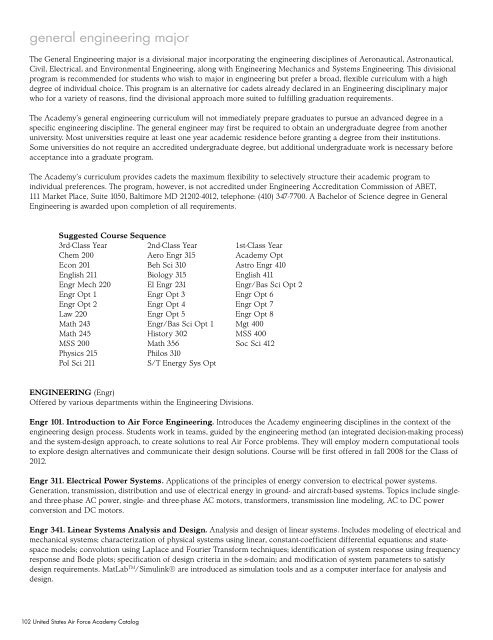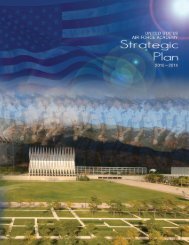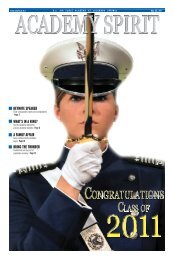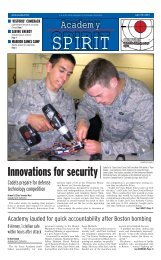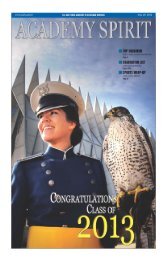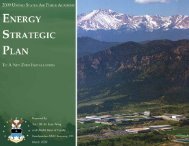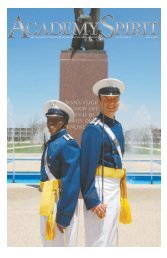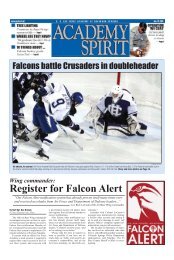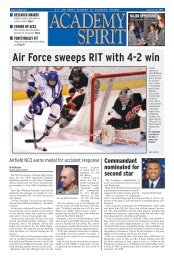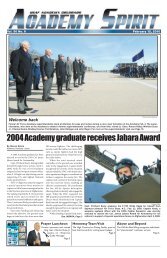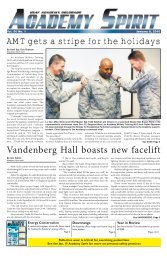2008-2009 Catalog - United States Air Force Academy
2008-2009 Catalog - United States Air Force Academy
2008-2009 Catalog - United States Air Force Academy
You also want an ePaper? Increase the reach of your titles
YUMPU automatically turns print PDFs into web optimized ePapers that Google loves.
general engineering major<br />
The General Engineering major is a divisional major incorporating the engineering disciplines of Aeronautical, Astronautical,<br />
Civil, Electrical, and Environmental Engineering, along with Engineering Mechanics and Systems Engineering. This divisional<br />
program is recommended for students who wish to major in engineering but prefer a broad, flexible curriculum with a high<br />
degree of individual choice. This program is an alternative for cadets already declared in an Engineering disciplinary major<br />
who for a variety of reasons, find the divisional approach more suited to fulfilling graduation requirements.<br />
The <strong>Academy</strong>’s general engineering curriculum will not immediately prepare graduates to pursue an advanced degree in a<br />
specific engineering discipline. The general engineer may first be required to obtain an undergraduate degree from another<br />
university. Most universities require at least one year academic residence before granting a degree from their institutions.<br />
Some universities do not require an accredited undergraduate degree, but additional undergraduate work is necessary before<br />
acceptance into a graduate program.<br />
The <strong>Academy</strong>’s curriculum provides cadets the maximum flexibility to selectively structure their academic program to<br />
individual preferences. The program, however, is not accredited under Engineering Accreditation Commission of ABET,<br />
111 Market Place, Suite 1050, Baltimore MD 21202-4012, telephone: (410) 347-7700. A Bachelor of Science degree in General<br />
Engineering is awarded upon completion of all requirements.<br />
Suggested Course Sequence<br />
3rd-Class Year 2nd-Class Year 1st-Class Year<br />
Chem 200 Aero Engr 315 <strong>Academy</strong> Opt<br />
Econ 201 Beh Sci 310 Astro Engr 410<br />
English 211 Biology 315 English 411<br />
Engr Mech 220 El Engr 231 Engr/Bas Sci Opt 2<br />
Engr Opt 1 Engr Opt 3 Engr Opt 6<br />
Engr Opt 2 Engr Opt 4 Engr Opt 7<br />
Law 220 Engr Opt 5 Engr Opt 8<br />
Math 243 Engr/Bas Sci Opt 1 Mgt 400<br />
Math 245 History 302 MSS 400<br />
MSS 200 Math 356 Soc Sci 412<br />
Physics 215 Philos 310<br />
Pol Sci 211<br />
S/T Energy Sys Opt<br />
ENGINEERING (Engr)<br />
Offered by various departments within the Engineering Divisions.<br />
Engr 101. Introduction to <strong>Air</strong> <strong>Force</strong> Engineering. Introduces the <strong>Academy</strong> engineering disciplines in the context of the<br />
engineering design process. Students work in teams, guided by the engineering method (an integrated decision-making process)<br />
and the system-design approach, to create solutions to real <strong>Air</strong> <strong>Force</strong> problems. They will employ modern computational tools<br />
to explore design alternatives and communicate their design solutions. Course will be first offered in fall <strong>2008</strong> for the Class of<br />
2012.<br />
Engr 311. Electrical Power Systems. Applications of the principles of energy conversion to electrical power systems.<br />
Generation, transmission, distribution and use of electrical energy in ground- and aircraft-based systems. Topics include singleand<br />
three-phase AC power, single- and three-phase AC motors, transformers, transmission line modeling, AC to DC power<br />
conversion and DC motors.<br />
Engr 341. Linear Systems Analysis and Design. Analysis and design of linear systems. Includes modeling of electrical and<br />
mechanical systems; characterization of physical systems using linear, constant-coefficient differential equations; and statespace<br />
models; convolution using Laplace and Fourier Transform techniques; identification of system response using frequency<br />
response and Bode plots; specification of design criteria in the s-domain; and modification of system parameters to satisfy<br />
design requirements. MatLab TM /Simulink® are introduced as simulation tools and as a computer interface for analysis and<br />
design.<br />
102 <strong>United</strong> <strong>States</strong> <strong>Air</strong> <strong>Force</strong> <strong>Academy</strong> <strong>Catalog</strong>


